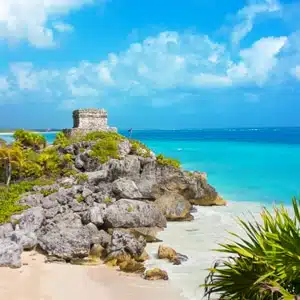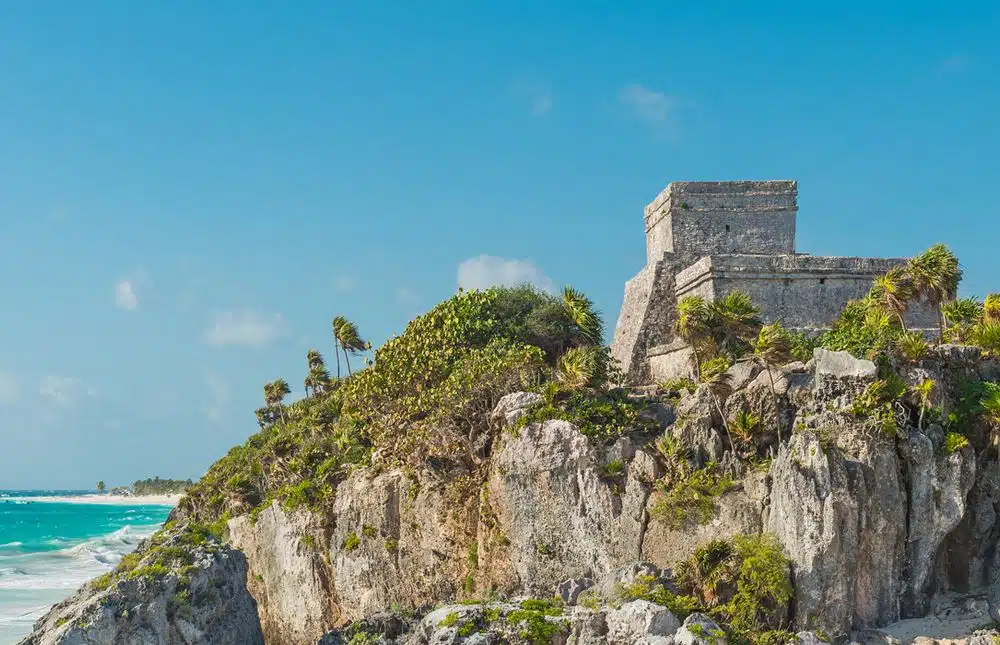2,000 years before our time, this civilisation which stood out due to its great wisdom and expressed itself through sun-worshipping, has left its mark with pyramids which served as tombs for its kings. Next stop the Yucatan, Mexico, and its Mayan remains, in 5 can’t-miss stops.
In the far-eastern part of the country, the Yucatan State proudly displays the age-old marks of one of the greatest pre-Columbian civilisations: the Mayans. Even if their territory stretched beyond the current borders of Mexico, it is in the Yucatan where the most impressive remains are preserved, including:
1. Uxmal – intact
Situated in the north-west of the Mexican province, the site known as Uxmal is intriguing due to its state of preservation. Its ancient ruins are more than 1,000 years old, yet they feature architectural details which are still preserved.
From the façades of its Palace of the Governors to the sides of its pyramid, you’re drawn in and captivated. You almost feel as though you’re in the presence of the thousands of souls who once lived in the city-state. Explorers will get the chance to meet Chaac, the serpent deity of the rain. His head is depicted in numerous places around the city.
2. Calakmul – impenetrable
Off the beaten track in the middle of a tropical forest on the Guatemalan border, Calakmul is the least visited Mayan site in the country thanks to its remote location. Its stone structures are worth the trip, after a journey through the wilderness where the traveller is immersed in nature, beauty and power. Once at the top of the impressive main building, a sea of green spreads out before you, the second largest jungle in South America after the Amazon. Breathtaking.
3. Chichen Itza – emblematic
In the region’s north, you get to Chichen Itza to find yourself in a familiar place. You already know this site without ever having set foot there. Why? El Castillo, its pyramid that, because of being highlighted by thousands of guides and appearing in all of the documentaries on the subject, has ended up becoming the symbol of Mexican Mayan heritage.
But again, nothing is as good as the real experience. Enormous and imposing, the building was constructed in homage to the Mayan calendar. At its base, the ball game area recalls the civilisation’s thirst for human sacrifice. The losers of the game were offered to the god Quetzalcoatl (the celebrated feathered Serpent), master of the place and omnipresent figure.
4. Tulum – turquoise
In the province of Quintana Roo, to the south of Cancun, Tulum is archaeologically modest but geographically magnificent thanks to its location. Built atop a rocky outcrop, this site is among the most recent (between 1200 and 1500 AD). It was a port city lying on a shore of turquoise water and a white sand beach. Everything comes together here in an awe-inspiring visual experience making it a true delight for the eyes.
5. …and the Ruta Puuc
“Route”, meaning way, and “Puuc”, referring to this post-Mayan civilisation which grew in the Mérida region. The little sites strewn around it (Sayil, Xlapak, Kabah and Labna) are all evidence of the architecture called the Puuc style. Elongated buildings and sculptured stones with enormous mosaics embedded into the walls. For this reason, a stop at Kabah with its 300 masks of Chaac is a must.
A trip to the centre of the stone ruins to get beyond the Mexico of clichés and to the limits of humankind.

Explore the Yucatan
Chichen Itza, Tulum, Uxmal… Ponant takes you to discover Mayan treasures in Mexico.



